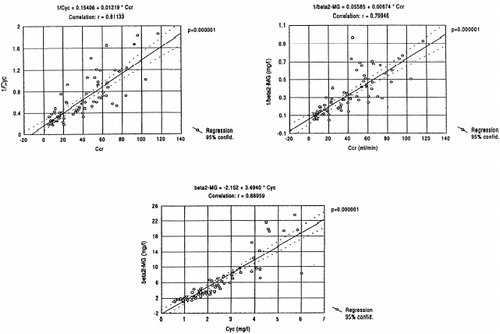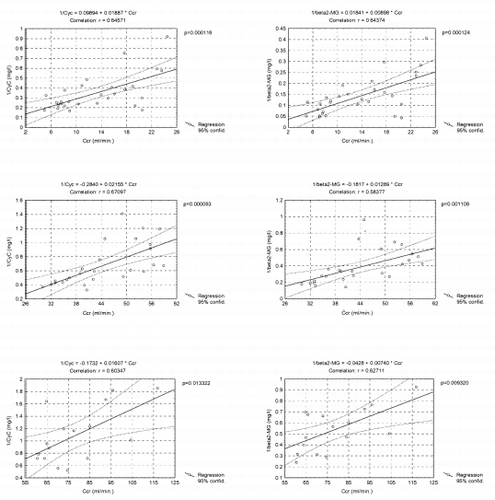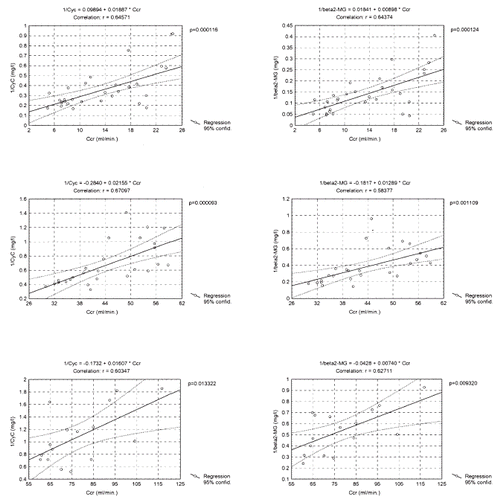Abstract
Continuous efforts have been made to find out precise and simple method for determination of glomerular filtration rate (GFR). Cystatin C (cysteine proteinase inhibitor = CyC) is a low molecular weight (LMW) protein which is produced constantly by all nucleated cells independently of different pathological conditions and eliminated from the blood exclusively by glomeruli. So, CyC closely reflects the GFR. In the present study 75 patients aged between 18 and 74 (44.3 ± 12.2) years were analyzed, with the aim to compare the reciprocal values of serum level of LMW proteins CyC and β2-microglobulin (β2-MG) with creatinine clearance (Ccr) as a measure of GFR. Patients were divided into groups according to sex, age (<60; >60 years) and renal diseases: patients with glomerulonephritis (GN) with and without nephrotic proteinuria, pyelonephritis (PyN), and renal transplant (Tx). High correlation between Ccr and 1/CyC (r = 0.81; p<0.01) and Ccr and 1/β2-MG (r = 0.80; p<0.01) in all examined patients was found. There was significant correlation between Ccr and 1/CyC (0.82 vs. 0.79) and Ccr and 1/β2-MG (0.85 vs. 0.76) in men as well in women, and also in two groups of patients formed according to the age (0.82 vs. 0.77; p<0.01; 0.80 vs. 0.81; p<0.01), without any statistical significant difference between the groups. In studied groups with different renal diseases, there were no differences in correlation coefficients between Ccr and 1/CyC and Ccr and 1/β2-MG (p1 = 0.29; p2 = 0.21; p3 = 0.79; p4 = 0.43), without statistical differences between the groups, except significant difference in correlation coefficients for Ccr and 1/β2-MG between patients with GN with and without nephrotic proteinuria (p<0.032). LMW proteins, serum CyC and β2-MG, are as good markers of GFR as Ccr, regardless sex and age. Both of these LMW proteins are good markers of GFR in patients with GN without nephrotic proteinuria, PyN and Tx patients. In patients with GN and nephrotic proteinuria serum CyC is a better marker of GFR than β2-MG.
Introduction
The glomerular filtration rate (GFR) is generally considered the best measure of renal function despite the fact that the kidney performs various functions, including maintenance of salt and water balance, acid–base balance, blood pressure control as well as numerous endocrine functions.
GFR is traditionally measured as a renal clearance of particular substance from plasma. The ideal marker for measurement of GFR should be endogenously in the plasma at the constant rate, freely filtered at the glomerulus, neither reabsorbed nor secreted by renal tubule, without extrarenal elimination. Although the ideal marker for measuring GFR has not been found yet, its characteristics can be useful for comparing the advantages and disadvantages of new methods for GFR measurement.Citation[[1]]
Different methods for GFR evaluation have been used in nephrology practice and investigations (serum level of creatinine and urea, clearance of creatinine, inulin, various radionuclides), but in the last decades the determination of low molecular weight proteins has been proposed. Following low molecular weight (LMW) proteins have been used: α1—microglobulin (protein HC), retinol binding protein, β2—microglobulin (β2-MG), cystatin C (χ—trace, post-χ-globulin, CyC).Citation[[2]], Citation[[3]], Citation[[4]] Although they have been tested as new markers of GFR, there are no data about their use in patients with various renal diseases.
The aim of this study was to compare the reciprocal values of serum level of low molecular weight proteins cystatin C and β2-microglobulin with creatinine clearance as a measure of GFR in the patients with different age, sex, renal disease and renal function.
Subjects and Methods
The study included 75 patients (34 men and 41 women) aged between 18 and 74 (44.3 ± 12.2) years with various renal diseases and renal function who were treated at Clinic of Nephrology, Institute of Urology and Nephrology, Clinical Center of Serbia, during 1999.
We used N Latex cystatin C and β2-microglobulin for the Behring Nephelometer System. Creatinine was determined with Jaffe-reaction in serum and 24 h urine and creatinine clearance was calculated by standard formula.
Statistical Methods
All clinical and biochemical parameters were statistically analyzed. Reciprocal values of serum cystatin C and β2-microglobulin were compared with creatinine clearance. The correlation was calculated according to Pearson. Correlation coefficients were compared after Fisher transformation. Differences among groups were tested with ANOVA.
Results
presents correlation between creatinine clearance and reciprocal values of cystatin C (r = 0.811; p<0.001) and creatinine clearance and reciprocal values of β2-microglobulin (r = 0.799; p<0.001) in all examined patients. Statistically significant correlation was found for both LMW proteins. There were no differences in correlation coefficients between these two LMW proteins and creatinine clearance (p = 0.685). Besides, high significant correlation between serum CyC and serum β2-MG (r = 0.889; p<0.001) in all examined patients was found as well.
Figure 1. Correlation between creatinine clearance and 1/CyC and creatinine clearance and 1/β2-MG as well as CyC and β2-MG in all examined patients.

Although, no significant difference was found in mean creatinine clearance between men and women (), the mean serum CyC and β2-MG were significantly higher in men than in women (46% higher for CyC; 89% higher for β2-MG) (p<0.025). Correlation between creatinine clearance and 1/CyC (0.825 vs. 0.792) and creatinine clearance and 1/β2-MG (0.852 vs. 0.761) was similar in men and in women. There was no difference in mean creatinine clearance, serum CyC and β2-MG between younger and older patients. also presents strong correlation between creatinine clearance and 1/CyC and creatinine clearance and 1/β2-MG in two groups of patients formed according to the age, without statistical significant difference between the groups.
Table 1. Creatinine clearance, serum level of cystatin C, β2-microglobulin and their correlations in groups of patients formed according to sex and age
Correlation between creatinine clearance and 1/CyC and creatinine clearance and 1/β2-MG in patient groups formed according to various renal function (Ccr>60; 25–60; <25 mL/min) can be seen in . In all groups of patients there was strong correlation between creatinine clearance and 1/CyC as well as creatinine clearance and 1/β2-MG. There were no differences in correlation coefficients between creatinine clearance and 1/CyC and creatinine clearance and 1/β2-MG in all three groups of patients. There were no differences in these parameters between the groups either. According to renal diseases patients were divided in four groups: patients with glomerulonephritis with nephrotic proteinuria (prt>3.5 g/24 h) (20 patients), patients with glomerulonephritis without nephrotic proteinuria (prt<3.5 g/24 h) (30 patients), patients with pyelonephritis (5 patients) and renal transplant patients (20 patients).
Figure 2. Correlation between creatinine clearance and 1/CyC and creatinine clearance and 1/β2-MG in patients with different renal function (first row: Ccr<25 mL/min; second row: Ccr 25–60 mL/min; third row: Ccr>60 mL/min).

Similar relationship between creatinine clearance and 1/CyC and creatinine clearance and 1/β2-MG was found in patients with glomerulonephritis and nephrotic syndrome (p = 0.291), glomerulonephritis without nephrotic proteinuria (p = 0.211), pyelonephritis (p = 0.795), as well as in renal transplant patients (p = 0.434) ().
Figure 3. Correlation between creatinine clearance and 1/CyC and creatinine clearance and 1/β2-MG in patient groups formed according to the primary renal diseases (first row: pts with glomerulonephritis without nephrotic proteinuria; second row; patients with glomerulonephritis with nephrotic proteinuria; third row: patients with pyelonephritis; fourth row: renal transplant patients).

Comparison of the correlation coefficients between creatinine clearance and 1/CyC for the groups with various renal diseases revealed no differences. However, when we compared the correlation coefficients between creatinine clearance and 1/β2-MG significant difference was found between patients with glomerulonephritis without and with nephrotic proteinuria (r1 = 0.889; r2 = 0.625; p<0.032).
Discussion
The kidneys play an important role in the metabolism of most low molecular weight proteins, as these proteins are filtered in the glomeruli and then reabsorbed and catabolized by the proximal tubular cells or excreted in the urine.Citation[[5]], Citation[[6]] If the synthesis, distribution volume and other catabolic pathways of LMW proteins are relatively stable, the serum concentration of such proteins can be a good measure of the GFR.Citation[[2]]
Retinol binding protein, α1—microglobulin and β2—microglobulin have not been useful for measuring of GFR because of the influence of non-renal factors on their circulatory concentrations, as well as their production rate.Citation[[7]] Their serum level raised in patients with inflammatory, immunologic and neoplastic disorders without impaired GFR.Citation[[5]], Citation[[6]] The production rate of these LMW proteins may vary due to infection, dietary factors and liver disease.Citation[[4]], Citation[[8]], Citation[[9]]
Cystatin C (χ trace or post χ-globulin), has nearly the same molecular weight as a β2-MG (13 359 kD vs. 11 800 kD) and is physiological inhibitor of cystein proteinases.Citation[[2]], Citation[[9]] CyC is produced by all nucleated cells at the constant rate independently of different pathological conditions. Its production or blood concentration, is not altered by inflammation so, it is not an acute phase protein.Citation[[9]] CyC is eliminated from the blood exclusively by the GFR so, its concentration closely reflects the GFR and it has been suggested as a new marker of GFR.Citation[[7]]
When we compared the mean serum concentration of CyC and β2-MG in men and women we found that they were higher in men with high significant difference, which is in accordance with Newman et al.,Citation[[10]] but not with Erlandsen et al.Citation[[11]] Some other authors, also indicated differences in CyC concentration between men and women, but non-significant.Citation[[7]], Citation[[12]] At the same time correlation coefficients between creatinine clearance and 1/CyC and creatinine clearance and 1/β2-MG were similar in men and women (p1 = 0.692; p2 = 0.277).
The mean values of serum CyC and β2-MG were higher in younger patients than in older, but our results showed non-significant difference similarly as some previously reported studies.Citation[[13]] On the contrary, the other authors described the increase of serum CyC and β2-MG with age,Citation[[11]] especially after 50 years.Citation[[12]], Citation[[14]] Both, 1/CyC and 1/β2-MG correlated significantly with creatinine clearance in two groups of patients with different age (p1 = 0.766; p2 = 0.306) ().
There were no differences in correlation coefficients between creatinine clearance and 1/CyC, as well as between creatinine clearance and 1/β2-MG in patient groups with different renal function (). Serum CyC levels started to increase over normal range when GFR fell below 90 mL/min/1.73 m2 according to Coll et al.,Citation[[15]] or 94.4 mL/min/1.73 m2 according to Tian et al.,Citation[[16]] while serum creatinine remained within normal range, which is not in correlation with our findings. Mussap found that serum CyC and serum creatinine values correlated in patients with creatinine clearance less than 80 mL/min/1.73 m2.Citation[[12]] Serum CyC levels are significantly different between patients with normal renal function and patients with mild to moderate decrease in glomerular filtration rate.Citation[[12]] So, many authors suggest that measurement of serum CyC is useful to estimate GFR, especially to detect the mild reductions of GFR.Citation[[15]], Citation[[17]] We found significant correlation between creatinine clearance and 1/CyC as well as creatinine clearance and 1/β2-MG in all examined groups according to renal function (Ccr>60 mL/min; 25–60 mL/min; <25 mL/min) and between the groups too.
There are no many papers on serum CyC values as a measure of GFR in various renal diseases. Tian et al. found no correlation between LMW proteins CyC and β2-MG with kind of renal diseases.Citation[[16]] In our study patients with glomerulonephritis with and without nephrotic proteinuria, pyelonephritis and renal transplant patients were examined. We found no differences in correlation coefficients between creatinine clearance and 1/CyC and creatinine clearance and 1/β2-MG in groups of patients with different renal diseases. The best correlation between these values was found in patients with pyelonephritis.
In renal transplant patients rapid assessment of graft function (GFR) is necessary. This allows for early recognition of rejection as well as accurate dosing of different simultaneously used drugs. Study of Risch et al.Citation[[18]] suggested that the serum CyC was very good marker for GFR in renal transplant patients.Citation[[19]] During inflammatory processes or other additional conditions, especially during acute rejection or infections, CyC also provided precise assessment of GFR while creatinine clearance varied dramatically.
The serum concentration of β2-MG depends on its production rate and the GFR.Citation[[14]] Its production is dramatically different in patients with lymphoproliferative syndromes, infections and autoimmune diseases.Citation[[18]] Immunosuppressive drugs will also change the rates of β2-MG production, making it impractical for GFR marker in patients with renal transplants. So, Risch et al. considered that serum CyC was better marker for GFR than β2-MG in renal transplant patients with different complications.Citation[[18]] Our study found no difference between CyC and β2-MG as markers of GFR in renal transplant patients (), but all of them were in stable condition at the time of study.Citation[[20]]
Comparison of correlation coefficients between creatinine clearance and 1/CyC in all examined groups formed according to the primary renal diseases revealed no difference. But when we compared the correlation coefficients between creatinine clearance and 1/β2-MG in the same examined groups significant difference was found between patients with glomerulonephritis with and without nephrotic proteinuria.
In conclusion, low molecular weight proteins, serum CyC and β2-MG, were as good markers of GFR as creatinine clearance, regardless of sex, age, and renal function. Both of these LMW proteins are good markers of GFR in patients with glomerulonephritis without nephrotic proteinuria, pyelonephritis and renal transplant. In patients with glomerulonephritis and nephrotic proteinuria serum CyC is a better marker of GFR than β2-MG.
Fast development of various kinds of therapies in patients with various diseases especially patients from risk groups (patients from intensive care units, patients with renal transplant, pregnant women, diabetic patients, patients who need nephrotoxic therapy) arise the request of fast, safe and simple method for GFR measurement. Serum CyC, new LMW protein, with its stable production unrelated of sex, age, various pathological condition, various diseases and its activity, may replace creatinine and creatinine clearance in the medical practice, but further clinical investigations are warranted.
References
- Swan K.S. The search continuous—an ideal marker of GFR. Clin. Chem. 1997; 43(6)913–914
- Simonsen O., Grubb A., Thysell H. The blood serum concentration of cystatin C (χ-trace) as a measure of the glomerular filtration rate. Scand. J. Clin. Lab. Invest. 1985; 45: 97–101
- Colle A., Tavera C., Previt D., Leung-Tack J., Thomas J., Mannel Y., Benveniste J., Leibowitch J. cystatin C levels in sera of patients with human immunodeficiency virus infection. J. of Immunoassay 1992; 13(1)47–60
- Finney H., Newman J.D., Gruber W., Merle P., Price P.Ch. Initial evaluation of cystatin C measurement by particle-enhanced immunonephelometry on the Behring nephelometer systems (BNA, BN II). Clin. Chemistry 1997; 43(6)1016–1022
- Wibell L., Evrin P.E., Berggard I. Serum β2-microglobulin in renal disease. Nephron 1973; 10: 320–331
- Trollfors B., Norrby R. Estimation of glomerular filtration rate by serum creatinine and serum β2-microglobulin. Nephron 1981; 28: 196–199
- Newman J.D., Thakkar H., Edwards G.R., Wilkie M., White T., Grubb O.A., Price P.Ch. Serum cystatin C measured by automated immunoassay: a more sensitive marker of changes in GFR than serum creatinine. Kidney Int. 1995; 47: 312–318
- Grubb A., Simonsen O., Sturfelt G., Truedsson L., Thysell H. Serum concentrations of cystatin C, factor D and β2-microglobulin as a measure of glomerular filtration rate. Acta Med. Scand. 1985; 218: 499–503
- Grubb A. Diagnostic value of analysis of cystatin C and protein HC in biological fluids. Clin. Nephrol. 1992; 38(suppl 1)S20–S27
- Newman J.D., Thakkar H., Edvards G.R., Wilkie M., White T., Grubb O.A., Price P.Ch. Serum cystatin C: a replacement for creatinine as a biochemical marker of GFR. Kidney Int. 1994; 46(suppl 47)S20–S21
- Erlandsen J.E., Randers E., Kristensen H.J. Reference intervals for serum cystatin C and serum creatinine in adults. Clin. Chem. Lab. Med. 1998; 36(6)393–397
- Mussap M., Ruzzante N., Varagnolo M., Plebani M. Quantitative automated particle-enhanced immunonephelometric assay for the routinary measurement of human cystatin C. Clin. Chem. Lab. Med. 1998; 36(11)859–865
- Jovanovic D., Krstivojevic P., Obradovic I., Djurdjevic V., Djukanovic Lj. Serum cystatin C as a measure of GFR in patients with various renal function. ERA-EDTA Congress XXXVII, NicaFrance, Sept 17–20, 2000, Nephrol. Dial. Transplant. 2000, 15, A125
- Norlund L., Fex G., Lanke J., Von Schenck H., Nilsson E., Leksell H., Grubb A. Reference intervals for the glomerular filtration rate and cell proliferation markers: serum cystatin C and serum β2-microglobulin/cystatin C relatio. Scand. J. Clin. Lab. Invest. 1997; 57(6)463–470
- Coll E., Botey A., Alvarez L., Poch E., Saurina A., Vera M., Piera C., Darnell A. cystatin C as a new marker of glomerular filtration rate. ERA-EDTA Congress XXXVI, MadridSpain, Sept 5–8, 1999, Abstracts book, 198
- Tian S., Kusano E., Ohara T., Tabei K., Hoh Y., Kawai T., Asano Y. cystatin C measurement and its practical use in patients with various renal diseases. Clin. Nephrol. 1997; 48(2)104–108
- Randers E., Erlandsen E.J., Pedersen O.L., Hasling C., Danielsen H. Serum cystatin C as an endogenous parameter of the renal function in patients with normal to moderately impared kidney function. Clin. Nephrol. 2000; 54(3)203–209
- Risch L., Blumberg A., Huber A. Rapid and accurate assessment of glomerular filtration rate in patients with renal transplants using serum cystatin C. Nephrol. Dilal. Transplant. 1999; 14(8)1991–1996
- Paskalev E., Lambreva L., Simeonov P., Koicheva N., Beleva B., Genova M., Marcovska R., Nashkov A. Serum cystatin C in renal transplant patients. Clin. Chim. Acta 2001; 310(1)53–56
- Donadio C., Lucchesi A., Ardini M., Giordani R. cystatin C, β2-microglobulin and retinol-binding protein as indicators of glomerular filtration rate: comparison with plasma creatinine. J. Pharm. Biomed. Anal. 2001; 24(5–6)835–842